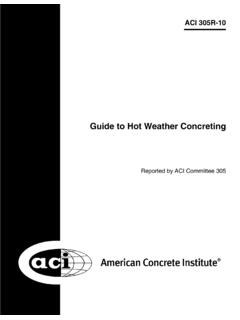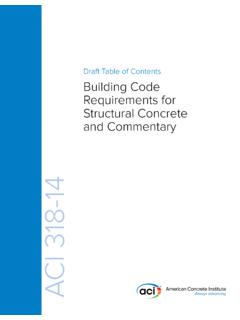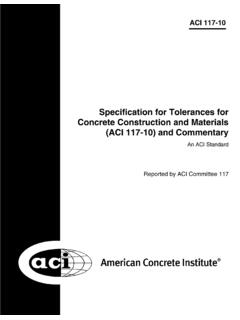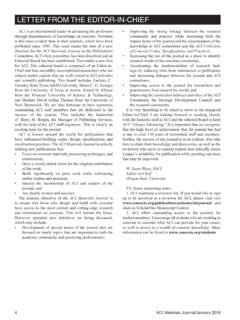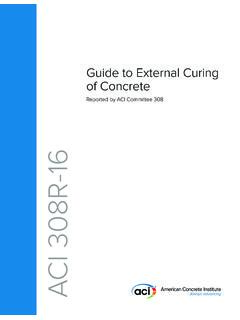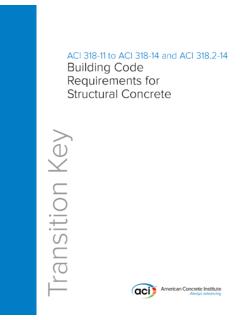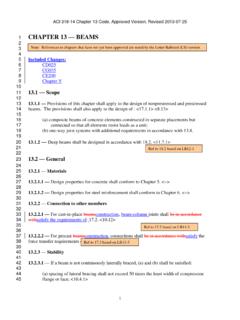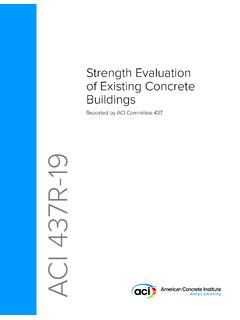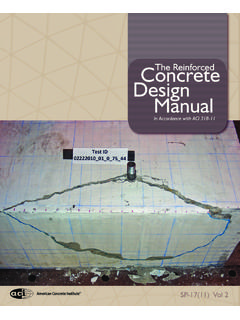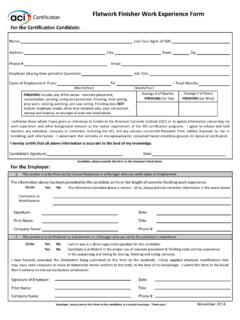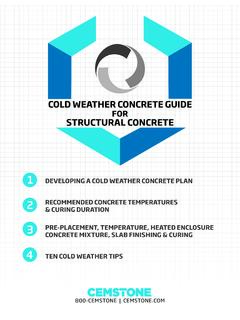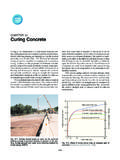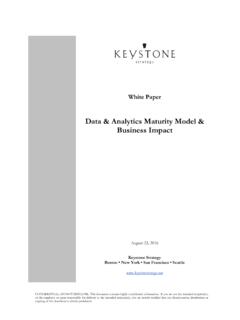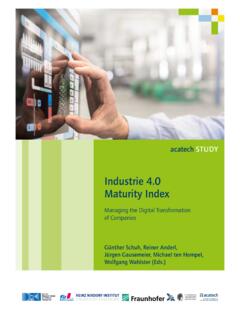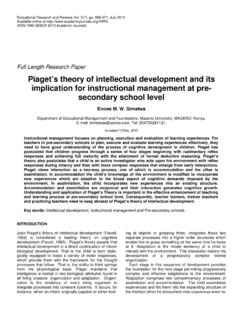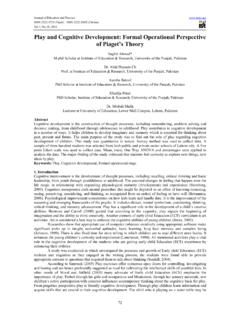Transcription of 306R-16: Guide to Cold Weather Concreting
1 Guide to Cold Weather ConcretingReported by ACI Committee 306 ACI 306R-16 First PrintingSeptember 2016 ISBN: 978-1-945487-15-6 Guide to Cold Weather ConcretingCopyright by the American concrete Institute, Farmington Hills, MI. All rights reserved. This material may not be reproduced or copied, in whole or part, in any printed, mechanical, electronic, film, or other distribution and storage media, without the written consent of technical committees responsible for ACI committee reports and standards strive to avoid ambiguities, omissions, and errors in these documents. In spite of these efforts, the users of ACI documents occasionally find information or requirements that may be subject to more than one interpretation or may be incomplete or incorrect. Users who have suggestions for the improvement of ACI documents are requested to contact ACI via the errata website at Proper use of this document includes periodically checking for errata for the most up-to-date committee documents are intended for the use of individuals who are competent to evaluate the significance and limitations of its content and recommendations and who will accept responsibility for the application of the material it contains.
2 Individuals who use this publication in any way assume all risk and accept total responsibility for the application and use of this information in this publication is provided as is without warranty of any kind, either express or implied, including but not limited to, the implied warranties of merchantability, fitness for a particular purpose or and its members disclaim liability for damages of any kind, including any special, indirect, incidental, or consequential damages, including without limitation, lost revenues or lost profits, which may result from the use of this is the responsibility of the user of this document to establish health and safety practices appropriate to the specific circumstances involved with its use. ACI does not make any representations with regard to health and safety issues and the use of this document.
3 The user must determine the applicability of all regulatory limitations before applying the document and must comply with all applicable laws and regulations, including but not limited to, United States Occupational Safety and Health Administration (OSHA) health and safety by governmental representatives in the work of the American concrete Institute and in the development of Institute standards does not constitute governmental endorsement of ACI or the standards that it information: ACI documents are available in print, by download, on CD-ROM, through electronic subscription, or reprint and may be obtained by contacting ACI standards and committee reports are gathered together in the annually revised ACI Manual of concrete Practice (MCP).American concrete Institute38800 Country Club DriveFarmington Hills, MI 48331 Phone: + : + document guides specifiers, contractors, and concrete producers through the selection processes that identify methods for cold Weather Concreting .
4 The objectives of cold Weather Concreting practices are to: a) prevent damage to concrete due to freezing at early ages; b) ensure that the concrete develops the recommended strength for safe removal of forms; c) maintain curing conditions that foster normal strength development; d) limit rapid tempera-ture changes; and e) provide protection consistent with intended serviceability of the structure. concrete placed during cold Weather will develop sufficient strength and durability to satisfy intended service requirements when it is properly proportioned, produced, placed, and : accelerating admixtures; antifreeze admixtures; cold Weather Concreting ; concrete temperature; curing; enclosures; form removal; freezing and thawing; heaters; heating aggregates; insulating materials; maturity testing; protection; strength 1 INTRODUCTION AND SCOPE, p.
5 Introduction, p. Scope, p. 2 CHAPTER 2 NOTATION AND DEFINITIONS, p. Notation, p. Definitions, p. 3 CHAPTER 3 OBJECTIVES, PRINCIPLES, AND ECONOMY, p. Objectives, p. Principles, p. Economy, p. 4 CHAPTER 4 GENERAL RECOMMENDATIONS, p. Planning, p. Protection during unexpected freezing, p. concrete temperature, p. Temperature records, p. Heated enclosures, p. Slab finishing, p. concrete workability, p. 5 CHAPTER 5 TEMPERATURE OF concrete AS MIXED AND PLACED, AND HEATING OF MATERIALS, p. Placement temperature, p. Mixing temperature, p. Heating mixing water, p. Heating aggregates, p. Steam heating of aggregates, p. 7 William J. Lyons III, ChairKevin A. MacDonald, Vice ChairErik Holck, SecretaryACI 306R-16 Guide to Cold Weather ConcretingReported by ACI Committee 306 Kim D.
6 BashamJames R. Baty IIMichael Patrick BerryCharles D. BinkowskiKen CannellaTerry C. CollinsD. Gene DanielDavid J. ElmerMario GarzaJohn P. GnaedingerRobert J. HoopesKenneth C. HoverEric D. KingRonald L. Kozikowski R. Lloyd J. MarcheseStephen C. MorricalCraig M. NewtsonWilliam D. Palmer R. PurintonDomenick Thomas RutturaValery TokarConsulting MembersTerry L. LavyRobert J. RyanHarold B. WenzelSixin YangVictor I. SubkovACI Committee Reports, Guides, and Commentaries are intended for guidance in planning, designing, executing, and inspecting construction. This document is intended for the use of individuals who are competent to evaluate the significance and limitations of its content and recommendations and who will accept responsibility for the application of the material it contains. The American concrete Institute disclaims any and all responsibility for the stated principles.
7 The Institute shall not be liable for any loss or damage arising to this document shall not be made in contract documents. If items found in this document are desired by the Architect/Engineer to be a part of the contract documents, they shall be restated in mandatory language for incorporation by the 306R-16 supersedes ACI 306R-10 and was adopted and published September 2016, American concrete rights reserved including rights of reproduction and use in any form or by any means, including the making of copies by any photo process, or by electronic or mechanical device, printed, written, or oral, or recording for sound or visual reproduction or for use in any knowledge or retrieval system or device, unless permission in writing is obtained from the copyright Overheating of aggregates, p.
8 Calculation of mixture temperature, p. Temperature loss during delivery, p. 7 CHAPTER 6 PREPARATION BEFORE Concreting , p. Preparation of surfaces in contact with fresh concrete , p. Massive metallic embedments, p. Subgrade condition, p. 8 CHAPTER 7 PROTECTION AGAINST FREEZING FOR concrete NOT REQUIRING CONSTRUCTION SUPPORTS, p. Protection methods, p. Protection period, p. Protection period for durability, p. Protection for strength gain, p. Temperature drop after removal of protection, p. Allowable temperature differential during stripping, p. 10 CHAPTER 8 PROTECTION AGAINST FREEZING FOR STRUCTURAL concrete REQUIRING CONSTRUCTION SUPPORTS, p. Introduction, p. Field-cured cylinders, p. In-place testing, p. Maturity testing, p. Attainment of design strength, p. Increasing early strength, p.
9 Cooling concrete , p. Estimating strength development, p. Removal of forms and supports, p. Estimating strength development: modeling cold Weather placements, p. 14 CHAPTER 9 EQUIPMENT, MATERIALS, AND METHODS OF TEMPERATURE PROTECTION, p. Introduction, p. Insulating materials, p. Selection of insulation when supplementary heat is not used, p. Selection of insulation for use with hydronic heaters, p. Heaters, p. Enclosures, p. Internal heating, p. Temperature monitoring, p. Temporary removal of protection, p. Insulated forms, p. 20 CHAPTER 10 CURING RECOMMENDATIONS AND METHODS, p. Introduction, p. Curing during the protection period inside an enclosure, p. Curing following the protection period, p. 21 CHAPTER 11 ACCELERATION OF SETTING AND STRENGTH DEVELOPMENT, p.
10 Introduction, p. Accelerating admixtures, p. Cold Weather admixture systems (CWASs), p. Rapid setting cements, p. 22 CHAPTER 12 REFERENCES, p. 22 Authored documents, p. 23 CHAPTER 1 INTRODUCTION AND IntroductionThe conditions of cold Weather Concreting exist when the air temperature has fallen to, or is expected to fall below, 40 F (4 C) during the protection period. The protection period is defined as the amount of time recommended to prevent concrete from being adversely affected by exposure to cold Weather during construction. concrete placed during cold Weather will develop sufficient strength and durability to satisfy the intended service recommendations when it is properly proportioned, produced, placed, and protected. The necessary degree of protection increases as the ambient temperature advantage of the opportunity provided by cold Weather to place low-temperature concrete .
